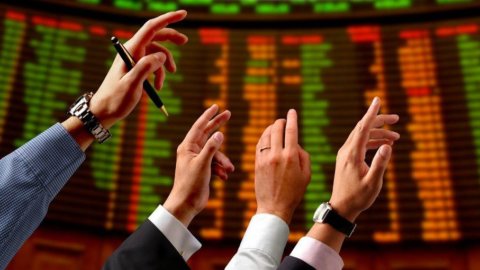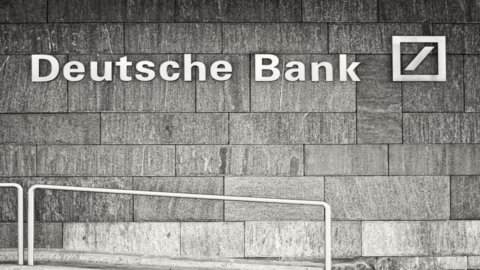The facts of our house
Performance of the Italian Stock Exchange in the last 17 years: since January 1996 (Base indexes Mediobanca free float) as at 18 October 2012 (approximately 16 years and 10 months), the most profitable investment on the Stock Exchange relates to savings shares, whose total return (including dividends) was equal to an average annual 8,2%.
Good performance of small caps (small companies, over the hundredth position in the ranking for free float capitalization) and companies mid cap (mid-cap companies, from the 31st to the 100th by free float market capitalization), with average annual returns of 4,4% and 6,3% respectively; both beat the blue chip whose quotations grew by an annual average of 4,8%.
As for the sectors, investment in banking stocks regularly loses compared to industrial stocks, whatever the year of the initial investment: since 1996, for example, it is an annual average of +1,5% compared to +7,8, 17% of the industrial portfolio (which in cumulative terms over approximately 28 years translates into +250% against +17%). But insurance stocks did even worse, only +17% in 1 years, i.e. +5,3% on average per year. Overall, the Stock Exchange returned about XNUMX% on average per year.
Since its establishment, the Star segment has always guaranteed better returns than the market, but above all the average of the Mid and SmallCap segments from which they originate - the only exception being the 2012 return below the 70 average -.
The investment in the Stock Exchange has closed negatively in 12 out of 17 years, i.e. for 14 years now except for 2002 and 2011. However, also for this figure the sectors make the difference: the last 15 out of 17 are the losing years for both insurance and banking investment, only 4 out of 17 for the industrial one (from 2005 onwards, except for 2008, 2009 and 2011). After having invariably lost from 2000 to 2009, the shares of the former Nuovo Mercato showed some signs of recovery, more evident in 2011.
Compared to an investment in BOTs, the Stock Exchange would have guaranteed an average annual return higher than the investment risk-free in three cases out of 17: in just the two initial periods (January and December 1996) and in the final one (December 2011), while even those who had the courage to invest in the Stock Exchange in the midst of the financial crisis (2008) would not have obtained returns higher than bots.
It remains to be assessed whether the higher return offered by the Stock Exchange was sufficient to compensate the investor for the higher risk assumed, taking into account a premium that fluctuates between 3,5% and 5%: this does not seem to have happened, not even for the investment made at a totally exceptional time (end of 2008) due to the financial crisis.
Dividend yield: in 2008 the fall in share prices in the presence of budget results (those of 2007) still not eroded by the crisis led to the dividend yield of the Italian Stock Exchange since 1996 (6,1%); banks in particular were able to consistently "reward" their shareholders (6,8%), but the palm of the best return goes to savings shares (7,5%), also at an all-time high since 1996.
In 2009, the fall in the dividend payout due to the meager balance sheet results in 2008 of insurance companies and banks depressed the dividend yield overall, bringing it to 4,3% (but in line with the levels of 2006 and 2007), thanks to the "resilience" of industrial stocks (6,4%) which achieved the second best result since 1996 and partly offset the fall of insurance companies (1,7%) and banks (just 0,8%).
2010 marks a further fall in dividends (from 4,3% to 4,1%, a level not seen since 2003), but it is now the industries that have closed their 2009 balance sheets lean, consequently reducing shareholder remuneration (at 4,8% from 6,4%) while insurance companies (from 1,7% to 2,8%) and banks (from 0,8% to 2,6%) are slightly recovering; the remuneration of savings shares was always strong (6,5%), in line with 2009.
In 2011 iI dividend yield shows a recovery – particularly due to the recovery of bank values from 2,6% to 2,9% - . In 2012, while remaining above 4% (as has occurred without interruption since 2004), it showed a new decline attributable to the contraction of insurance and banking - both sectors from 2,9% to 2,1% -, returning to the 4,1% achieved in 2010.
The Mid-caps, with the exception of the two-year period 1996/1997, have scored dividend yield regularly lower than the major companies (trend accentuated in recent years), so that their better overall returns are entirely attributable to price dynamics. The consideration is even more true for companies in the Star segment which have a particularly cautious dividend policy – the historical average since 2002 of their dividend-to-price ratio, 2,3%, is slightly more than half that of the Top 30, 4,3, XNUMX% -.
Long run = long fast? : the index of the Borsa Italiana from 2 January 1928 to the end of September 2012 expresses, in the dry price version, ie without the reinvestment of dividends, a nominal yield equal to 6,3% per annum. In real terms it becomes negative by 2,6% per annum (average inflation was 8,9%).
This means that a hypothetical investor who had decided to consume the dividends would have found himself after 84 years and 9 months with a capital with a purchasing power reduced by 89%. By calculating the index assuming total reinvestment of the dividends, the real average annual return is 0,8%, due to a dividend yield average in the period of 3,4%.
The reinvestment of the dividend is therefore necessary to maintain the initial purchasing power of the capital which, after setting 100 in January 1928, is equal to 198,7 at the end of September 2012.
When evaluating an investment in shares, it is essential to consider the horizon in which it takes place: assuming an investment period of just one year, the investor would have "risk" in the period in question of earning a maximum of 116% (in 1946 ) or lose 72% (1945) in the worst case scenario. As the investment period lengthens, the dispersion in average yearly results narrows.
Surprisingly, even if you hold the shares for 30 or 40 years, there is still the risk of suffering an average annual loss of between 3% and 4% (which means, in 40 years, impoverishing your capital despite having reinvested all dividends, as happened between 80 and 1944).
On the other hand, the timing of the investment is crucial. If one decides, unfortunately, to invest in a market peak, set equal to 100 the year in which it occurs, on average after 10 years there is immediately a halving of the capital, then recovering up to more than three quarters after twenty , while at the end of the thirtieth year there is still a loss, albeit slightly.
Average capital after: 10 years 51,8 euros -6,4% annual average
20 years 81,8 euro -1,0% annual average
30 years 97,6 euro -0,1% annual average
If, on the other hand, one had invested in one of the years in which the stock market index was at its lowest (in our survey: 1933, 1938, 1945, 1964, 1977 and 1992), on average after 10 years a value of the investment more than doubled and nearly quadrupled after 30 years.
Average capital after: 10 years 215,0 euros +12,2% annual average
20 years 265,3 euros +6,7% annual average
30 years 388,1 euros +5,4% annual average
Note, incidentally, the prolonged period from January 1928 to the end of 1985 which marks a total stagnation (almost sixty years) of the Italian stock exchange, with zero real returns and a substantial invariance in the number of listed issuers (from 176 in January 1928 to 165 at the end of 1985).
The individual titles: from riches to rags: A careful choice of stocks would have led to beating the Stock Exchange: for example, investing in Generali in January 1938 would have achieved in June 2012 an average real annual return (ie net of inflation, but excluding dividends) of 4,2% against a decrease of 2,2% on average per year on the Stock Exchange; or in Italcementi (+1,5% annual average in real terms) or Aedes (+0,8%), both positive, as well as better than the market average.
But it could have gone really bad by betting on Edison (-7% or -6,2%, depending on the starting share), on the old shares of the Orlando Group (now Intek) deriving from the old SMI (-6,1%) or from the old GIM (-5,8%) or again on the Bastogi (-6,9%) which is the longest-lived stock on the list, having been listed in 1863.
The list of negative yields (and below the average of the Stock Exchange) is long, even involving blue chips such as Italmobiliare (ex Franco Tosi) with -3,9%, Pirelli & C. (ex Pirelli Spa or “Pirellona”) with -2,7%, Telecom Italia ex SIP with -2,8% or ex Stet (-2,6 .1,4%). Still negative (although above the market average) are Pirelli & C. (formerly “Pirellina”) with -2,9% and Finmeccanica (-XNUMX%).
Price list, only 1 out of 4 positive: from the beginning of January 2011 to mid-October 2012, a period in which the stock market lost 22,7%, just one fifth of the shares recorded positive price changes (56 out of 271, 21%) and a good quarter (68 ) lost more than 50%.
Among the best: Txt e-Solutions (+182%), Vincenzo Zucchi savings (+164%), De' Longhi (+88%), Lottomatica Group (+85%) and Fullsix (+80%). Among the most negative trends, those of: Eukedos formerly Arkimedica (-99%), Seat PG (-91%), Sopaf (-91%), Fondiaria-Sai (-90%) and Arena (-89%).
Blue chips and the “risk premium”: The highest average annual total returns among the shares continuously "alive" since 1984 are: Generali for insurance companies (+6,9% against 7,9% of BTPs); Intesa Sanpaolo ex Nuovo Banco Ambrosiano, the only bank to beat the BTPs, which with 8,6% deserves the palm of best performers according to this particular classification (better than Mediobanca with +5,8% and UniCredit with +3,8%, both below the BTP); in industry only Gemina kept pace with the BTPs, having returned +8% on an annual average (followed by the other long-lived stocks: Fiat 5%, Pirelli & C. 5,5% and Finmeccanica 0,7%). Bringing up the rear, together with Fondiaria-SAI (-0,8%) Telecom (the old Olivetti), negative in the last 28 and a half years for an average annual -2,1%.
Stock exchange, the retreat of the banks: after the market turbulence that had reduced the value of the Italian Stock Exchange at the end of 2008 to around 370 billion euros (24% of the Italian GDP), there was a recovery to 458 billion at the end of 2009 (30% of the GDP) and then again a drop to 425 billion at the end of 2010, 332 at the end of 2011 and 326 last June (21% of GDP).
By mid-October, the value had risen to around 358 billion euros (around 23% of GDP).
The industrial sector, confined in the years of tree to a share that had reached its minimum representation at the end of 2005 (56% of total capitalization), from there it began a recovery that led it to rise progressively (58% in 2006, 61% in 2007, 64% in 2008 , 65% in 2009, 72% in 2010, up to 76% in 2011 and 77% in June 2012). The weight of banks has halved in just five and a half years, falling from 32% in 2006 to 16% in June 2012, the lowest level in the last 15 years.
The total dividends of all the listed companies reached the lowest value since 2000: 13,8 billion euros (-15,4%), with a breakdown between sectors that significantly benefited industry (87% against 79%) to the detriment of both banks (from 15% to 10%) and insurance companies (from 5% to 3%).
Both the banking and insurance sectors remain far from the peaks reached in the two-year period 2007-2008, when the amounts distributed were approximately eight times higher. Industry is holding up better, with dividends only 7% lower, reaching 12 billion, in any case approximately 30% lower than those of 2008.
Banks accounted for 10,2% of the dividends paid in 2012, representing about a sixth of the stock market value, but in 2008 credit institutions had managed to guarantee almost 36% of all dividends despite having a weight of 25% on the stock market. %; and again in 2007 they had represented almost 40% of all dividends despite being worth 30% of the entire Stock Exchange.
Multiples, between old and new equilibria: the ratio between price and earnings per share already started to fall in 2007 (from 21,5x to 19,2x), essentially due to the effect of the banking sector which was the first to experience a discrete reduction in prices in that year (a -11 % anticipator of the first signs of turbulence), even in the presence of profits not yet affected by the crisis.
In 2008 the multiple collapsed to 14,4x, not due to the effect of the banks, whose quotations (-56%) moved concurrently with the collapse of profits (-56%), but due to the decline in the quotations of industrial companies ; they left over 40% on the ground in the expectation of very pessimistic scenarios also for manufacturing, despite the presence of 2008 profits that were only partially affected (-7% for the major Groups), causing the sector multiple to fall from 19,9x at 13,1x (-33,5%).
In 2009, the performance of the accounts and the dynamics of the stock market tried to realign themselves after the "scrollone" of 2008, but still with "jerks" and fluctuations: the quotations of the banks grew by approximately 27%, profits decreased by the same amount (-25%) and the p/e rose to 21,3x (+27%), the highest level since 2003; industry, for its part, has seen the stock market value recover by around 25%, but in the presence of 2009 profits which are now actually down (around -37% for the major Groups), with a consequent rise in the P/E to 19,2 ,47x (+XNUMX%).
The substantial stability of 2010 was followed by a sharp fall in 2011 (P/E from 21,1x to 16,4x), accentuated in 2012 for insurance companies and banks, with industrial companies bucking the trend.
Instead, perhaps we need to get used to ratios structurally lower (at least for some sectors) as regards the P/BV (price on shareholders' equity per share): the fall in prices against lower earnings depresses this indicator whose denominator (equity) cannot fluctuate as profits: therefore, since 2008 the indicator has decreased and now seems to settle around 1,5x/1,6x, below its long-term level (1,8x) and far from the 2005-2007 levels stably above 2x. This seems to involve insurance companies very heavily (0,6x in June 2012 against a long-term average of 1,4x) and banks (0,6x against 1,3x), as much as, less intensely, industry (1,4x against 1,8 ,XNUMXx).
In 2012 just two new quotations: in 2011 they came out (delisted) from the Stock Exchange six companies against only two listings (Brunello Cucinelli and DeLclima), pending the IPO Sea. Since 1861, on average, 6,5 companies have been listed each year and 4,8 have been canceled with a balance of just under two companies per year.
Between 1951 and 1970, an average of three titles were listed each year and the same number were canceled, keeping the number of the list unchanged (about 130 titles).
From 1971 to 1985 there were an average of five quotations and three cancellations per year with a positive balance of two units, while the tree it has been since 1986: up to 2000 there were 18,5 new registrations per year, cancellations also increased to 10,7 units, with a largely positive balance (7,8 units).
Lastly, from 2001 to 2012, enrollments dropped significantly (12,3 units), against a further increase in cancellations (14,1 units), with a balance that became negative (slightly less than -2 units).
The data for the last decade would be much less positive without the effect of the transfer from the Expandi Market (formerly Ristretto) which brought 39 titles to the main market in 2009: without them, without prejudice to the 14,4 average annual cancellations, would be just 9,6, with a negative balance of 4,8 since 2001.
The privatization of the Stock Exchange? From 1998 to today (without the Expandi effect) it has produced a positive net balance of one company per year, but in the previous ten years (1986-1997, but the same would be true starting from 1980) the balance was approximately quadruple ( +4 units).
In cumulative terms, from 1990 to today (Table 7b) the list has depleted by 20 units, saved by the contribution (33 titles, of which 45 subscriptions and 12 cancellations) of the former Nuovo Mercato without which the balance would be negative for 53 titles.
Finally, the three negative net balances recorded in 2003 (-13 units), 2008 (-12) and 2009 (-11, without the Expandi effect), without considering the more recent -8 and -10 of 2010 and 2011, have few comparable or worse precedents throughout the last century: in 1934 (-13 units), in 1931 (-20), in 1918 (-38 units), in 1910 (-11).
Little relief came from AIM and MAC, which currently number 16 and 13 stocks with very small capitalizations.
Collection, after a strong low-key 2011 recovery in 2012: in 2011 capital increases were carried out for 12,5 billion, an amount far from the maximum (17,5 billion euro in 1999); the absolute prevalence of credit institutions (5 billion relating to Intesa Sanpaolo, 2,15 to Monte Paschi, 2 to Banco Popolare, 1 to UBI Banca and 0,8 to Banca Popolare di Milano).
The first six months of 2012 confirmed vivacity, with increases for a total of 7,8 billion, to be attributed almost entirely (96%) to the issue of UniCredit (7,5 billion) and for the residual portion to industry (0,3 billion ).
Since 1990, 156 billion euros have been collected, 56% of which from industry and about 36% from the banking sector. The latter has presented itself on the market with insistence since 2008, collecting 33,7 billion euros (almost double the 17,1 billion of the industry), equal to about 60% of the total raised since 1990.
In the same period, the industry requested, as a premium, a quota equal, on average, to 44,5% of the capital raised, against 71,4% of the insurance companies and 50,4% of the banks.
A look abroad
Borsa Italiana does not gain positions: at the end of 2002, our stock exchange was ninth in the world, with a capitalization of 458 billion euro, approximately 50% of the GDP at the time, an incidence not far from that of the German stock exchange.
We were overtaken by the great North American exchanges (NYSE, Nasdaq and Toronto) and European ones (London, the German stock exchange, the newly formed Euronext which had brought together Paris, Amsterdam and Brussels, as well as the Swiss stock exchange which had just overtaken us), as well as Tokyo.
In June 2012 we find the Italian Stock Exchange in 20th position, mainly as a result of the strong dynamism of emerging markets and the better performance of some European stock exchanges (Switzerland, Spain) and the Australian market, as well as for the consolidation of some individually smaller markets of ours (Stockholm, Helsinki and Copenhagen gathered in 2005 in the Nasdaq OMX Nordic).
After losing two positions both in 2003 and in 2005 (to the advantage, respectively, of Hong Kong-Spain and Australia-Nasdaq OMX Nordic) we have witnessed the overtaking of the BRIC and other emerging markets: in 2007 by Shanghai, Brazil and Bombay, in 2009 by Korea and Russia (after a first attempt for both in 2007, neutralized the following year) as well as Johannesburg, in 2010 by Taiwan.
Difficult to recover positions: these markets are on average, in terms of capitalization, 2,9 times the Italian one and their advantage varies from 63% (Taiwan) to 587% and 578% of Shanghai and Hong Kong (which had already overtaken since 2007 two traditionally sizable marketplaces such as Toronto and the German Stock Exchange).
It must also be considered that, even in a context of difficult financial markets, since the end of 2002 the Italian stock exchange has been the only one of the top 20 world stock exchanges to contract in terms of value (-29%), whereas the other western markets they recorded increases, sometimes contained (London +17%, Nyse +20% European Euronext +31%) and for others more marked (Frankfurt +45%, Zurich +61%, Nasdaq +87%); all markets outclassed by the explosion of emerging countries (Brazil +675%, Bombay +608%, Russia +596%, Shanghai +556%, Johannesburg +498%, Hong Kong +327%, Korea +292%).
The most evident effect of these different dynamics is the moderate increase in the overall value of the major world markets (+69% over the decade), as the sum of the 7.800 billion euros for mature economies (+40%) and the 7.700 generated by emerging ones (+391%).
The weight of stock exchanges in mature economies consequently decreased from 92% to 76% of the total and in this trends the incidence of the Italian Stock Exchange, already marginal at the end of 2002 (2,4%), suffered a significant decrease in June 2012 (1%).
Compared to GDP, the Italian Stock Exchange (21%) is the least representative among the top 20 international markets: of ours (20% against 28%): Frankfurt precedes us (44%), while all the others are over 50% of respective GDP (Shanghai is at 31%, but exceeds half of GDP thanks to Hong Kong). The weight of the Italian Stock Exchange on the GDP in June 2012 (20,7%) returned to the levels of 1996, after the maximum of 2000 when it was close to 70% (Table 11).
On the other hand, the incidence of equity is at an all-time high, over 28% of GDP (it was 8% in 1986). As a result, in June 2012, a ratio between equity and stock market value never reached since 1986, 1,36x; comparable levels were recorded only in 1992 (1,21x, but at the time the stock exchange was worth 85,5 billion euro) and in the two-year period 2009-2010 (1,07x and 1,15x).
It is essentially the effect of the low valuation recognized by the stock market for the equity capital of the largest companies.
Entrances and delisted: the moderate growth in the value of world stock exchanges is matched by a slight expansion in the number of listed issuers, whose consistency (relative to the 20 main international stock exchanges, in addition to the five minor EU markets; Korea was excluded due to unavailability of the necessary data) in the decade 2002-June 2012 by approximately 7%, from 25.600 units to approximately 27.400 (+1.800 units).
Also in this case, two different trends are highlighted: +14% for mature economies (over 1.700 issuers acquired) and substantial stability for emerging economies (+0,7%, for a hundred more issuers). On the basis of this parameter, the Italian Stock Exchange (-12%) is not holding up, worse than the average of advanced economies.
Examining the impact of the new prices and the delisted in the decade compared to stock of listed securities at the beginning of the period, it emerges that the new listings represented on average about 53% of the initial amounts, the cancellations 52% and therefore in ten years the lists change their skin for approximately half of their components (Table 12) .
In the case of Borsa Italiana, it seems to have shown a certain ability to attract new listings which represented 40% of the stock initial, against values equal to 38% for Tokyo, 33% for Germany, 29% for the European NYSE Euronext circuit or 17% for the Swiss stock exchange, but also a lower ability to retain the companies that then left our market in the same percentage (52%), more than what happened in Tokyo (30%), in Germany (37%), on the Euronext circuit (42%) or in Switzerland (23%).
Emerging high performance: in the period from January 2002 to mid-October 2012 (almost 11 years) emerging market stock market indices dominated in terms of performance annual average (expressed in euros and without dividends): Russia (+13,5% annual average which means having obtained 3,8 times the initial investment), Russia (+13,1%) with final value 3,6 times the investment, followed by Johannesburg (+12,1%), Brazil (+11,8%) and the Korean stock exchange (+7,7%), all of which recovered more than 2 times the investment at the beginning of 2002.
The only markets of mature economies to have guaranteed a positive average annual return since 2002 were the Australian one (+5,4%), the Danish stock exchange (5,3%), Toronto (+4,9%), the Swedish stock exchange (+3,3%) and Zurich (+1,5%); even the Nasdaq (+0,5%) and, albeit marginally, Frankfurt (+0,1%) entered positive territory, however beaten by Singapore (+5,8%).
The Italian Stock Exchange, negative by an annual average of 5,9%, is in the dark; he was the page of Helsinki (part of the Nasdaq OMX Nordic, -5,1%), of the two main exchanges of the former Euronext (Amsterdam -4,7%, Paris -2,1%), as well as of London (-1,4, 1,3%), Madrid (-1,2%) and New York (-XNUMX%).
Not all quoted is traded: on average for the decade 2002-2011, the Nasdaq remains the most active market by far in terms of trading measured by the turnover index (ratio of trading value/total capitalisation): 5,6 times against 1,94x for Korea and 1,70. XNUMXx of Germany.
The Nasdaq has invariably been the most liquid market since 2002, even if the exceptional performance average was particularly evident from 2007 onwards, with average values of 8,5 and a peak in 2008 (14,7x).
In this respect, the Italian Stock Exchange ranks immediately after Germany, with an average multiple for the period of 1,68x which places it, albeit slightly, ahead of Spain (1,55x), New York (1,43x) , as well as in Tokyo (1,19x), ex OMX (1,16x), ex Euronext (1,14x) and London (1,12x). The aggressive and rampant emerging markets are highly illiquid: 0,06x the Russian stock exchange, 0,28x the Bombay, 0,39x the Johannesburg, 0,5x the Brazilian.
Hong Kong (0,62x) is slightly better, while only Taiwan (1,58x) and Shanghai (1,22x) appear to be in line with the general average of the main markets (1,55x).
I multiple: the P/E ratio of the European insurance sector marks a long-term level (ten-year average) equal to 14,3x, lower than that of the Italian market equal to 18,6x.
In 2011, with prices still low, the P/E settled well below the long-term level (11,9x), a situation, this, not dissimilar from what happened in the United States, with a multiple just high (12,4x), albeit less distant from the ten-year average (14,7x).
Similarly, the European banking sector experienced a significantly compressed P/E in 2011 (8,4x), comparable to that of theannus horribilis 2008 (7,1x) and far from the average of the decade (12,9x); in the United States, on the other hand, during the development of the banking crisis, multiples initially maintained considerable stability (between 18,1x and 20x in the years from 2007 to 2009), to then experience a sharp fall between 2010 (14,6x) and 2011 (10,1x).
Also ratio industries generally appear to be down in 2011, both in Europe and in the USA. The P/E is on average higher in the United States than in Europe (ten-year average equal to 18,6x against 15,1x), above all due to the more generous valuation of banks (15,9x against 12,9x) and industries (20,7. 16,2x against XNUMXx) and matches in dividend yield on average higher in our continent (3,5% against 2,5%).
P/BV also appears to be chronically higher in the US. In any case, the particularly severe treatment that appears to emerge from the P/BV of both European and US banks should be noted, rarely exceeding one from 2008 onwards.
Both in Europe and in the United States (and as already seen also for Italy), the bank P/BV ratio nonetheless marks a break structural compared to the levels prevailing before 2008.
Spa Bags: the Stock Exchange management companies, continuing the recovery begun in 2010, seem to have completely neutralized the effects of the crisis that occurred in 2009.
The aggregate of eight of the largest companies (NYSE Euronext, Tokyo, Nasdaq OMX, London Group, Deutsche Boerse, Hong Kong, SIX Group-Switzerland and BME-Spain) marks a further expansion of turnover in 2010 equal to 4%. from 10 to 10,7 billion euros (above 2008 level); securities trading was the revenue item with the most marked improvements. Recovery in Borsa Italiana (whose economic and financial data, referring only to the parent company, do not include the subsidiaries Cassa di Compensazione e Garanzia, MTS and Monte Titoli), which sees revenues increase by 4,5% to 164 million euros and further decrease the stake in the consolidated London Group to 17% (from 21%).
The containment of operating costs (-3,7%) gives a further contribution to the growth of the industrial margin, which rises by 31%. Thanks to the notable improvement in the balance of extraordinary items (+355 million euros), which cushioned the increase in the tax burden (+345 million euros), the net result rose by 43%. ROE grew from 15,2% to 21,8%, a level similar to 2005 and second only to those (above 30%) of the two-year period 2006-2007.
The Tokyo Stock Exchange alone suffered a decrease in the net result (-23%); the profits of the remaining management companies are all up, particularly those of the London Group (more than tripled, mainly due to the effect of significant extraordinary income) and Deutsche Boerse (doubled mainly following the reduction of operating costs) and Nasdaq OMX (+60 %). Borsa Italiana also did well, with net profit growing by about a third like the SIX Group.
As for employees, after two years of stability their number showed an appreciable increase (+5%), supported by all the management companies examined even if only London Group (+24%) and Hong Kong Exchanges (+13%) showed growth rates above 4%. In terms of employees Borsa Italiana, numerically stable, now represents just 11% (in 2010 it was 14%) of the London Group.
The equity structure shows equity growth of 5,5% against a stock market value, relating only to listed companies (the managers of the Tokyo and Switzerland stock exchanges are not traded), which grew by 17%.





